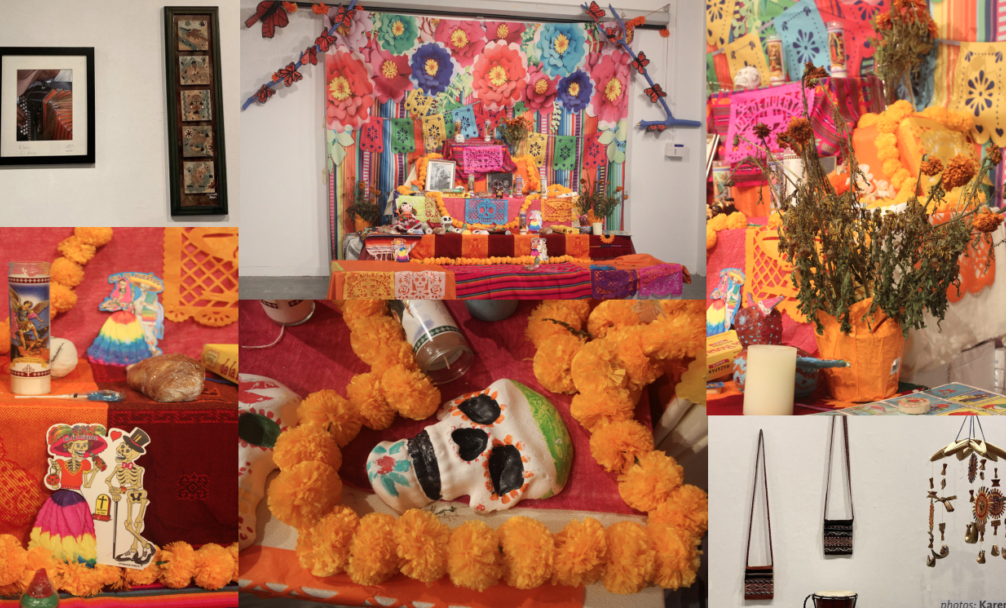PHS’s Numina Gallery showcases the diversity of Hispanic arts
November, 2021
From mid-September to mid-November, PHS celebrated Hispanic Heritage Month through various displays created by PHS students, teachers, and professional artists. These ranged from decorated homeroom doors to a vast array of artwork displayed in the Numina Gallery. This gallery has been previously used to present other culture-oriented exhibits, but this month’s purpose was to recognize the impact that Hispanic Americans have made in American history.
Established in 1968, Hispanic Heritage Month celebrates the achievements and contributions of those originating from Hispanic countries while also allowing members of the community to reconnect with their roots.
“[The purpose of] Hispanic Heritage Month is to talk about their experience. What is it like to be an immigrant here in the U.S? What are the dreams … What are the hopes they strive to have? What are their works, what are their contributions?” said PHS Spanish teacher Idania Rodriguez.
While other PHS celebrations, like the assemblies, spotlighted performing arts, students were able to enjoy visual arts at the exhibition in the Numina Gallery. Here, students could view an ofrenda, a traditional altar used on the Day of the Dead, as well as framed artwork, sculptures, and pottery by Hispanic artists.
“As for the Numina Gallery, you can observe so much from art and learn so much from it, no matter where it’s from. I think that art is such an important part in letting people express their feelings,” said Spanish teacher Martha Hayden. Seeing the product of an artist’s imagination creates a very deep emotional connection.
As the largest exhibit in the room, the ofrenda displayed candles, cempasuchil (Mexican marigold), decorative skulls, and photographs of family members, pets, and favorite objects of those who passed. Hayden explained that the three tiers comprising the altar symbolized the underworld, the earth, and the upper heavens, respectively. Contrary to popular belief, the Day of the Dead is actually a happy celebration for remembrance and reverence, not a time for mourning.
The Numina Gallery also embraced the wardrobes of Hispanic people. The mannequins, each wearing different textiles, were representative of unique, traditional Hispanic customs practiced in everyday life. Each textile was put together by the students of PHS art teacher Matthew Pembleton’s gallery club in order to present the different clothings of various Spanish-speaking countries, such as Guatemala, Peru, and El Salvador. The main point of this artwork was to give students a rare opportunity to learn about the history behind cultural traditions, like the standards and values that went in when creating the clothing and the geographical conditions that influenced each textile.
“Where do we come from? Who were our ancestors, and what did they wear?” Rodriguez said.
The beauty of the textiles lies in the process of their production. Instead of belonging to individuals, they were collaboratively stitched together, and everyone offered their personal contributions.
Further contributing to the diversity of the artwork, the walls of the Numina gallery displayed videos of students interviewing immigrants about their stories. The interviewees were asked about their backgrounds, specifically where they moved from, and why they moved to the United States.
“Each group interviewed at least one Spanish-speaking immigrant, and we asked about their cultural backgrounds and history. I think it’s cool that all of them had a different story and were willing to share their stories with us,” said Arunima Suri ’23. “It’s a nice addition to the Numina gallery, and I’m glad other students get to learn about this.”
The diversity of the forms of art in the Numina Gallery allowed PHS students to experience the beauty of Hispanic culture and understand its significance. Sasha Caracalos ’24 believes that an event like this is important not just to honor Hispanic culture but also to remember its history.
“It is critical that Hispanic artists be displayed, as they are primary sources of events not mentioned in most textbooks in the US. Many devastating events that have happened in countries are not displayed on the news and most individuals do not know about the state of these countries,” said Caracalos. “I believe that artists allow othe